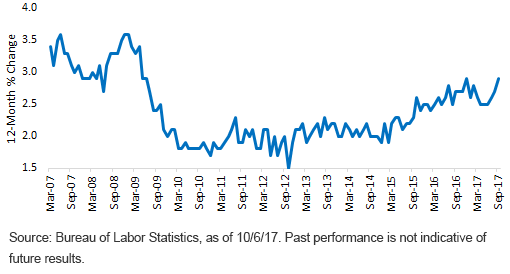September Wage Gains: Real Or Photoshopped?
Certainly one of the more disappointing aspects of the employment data over the last couple of years has been the lack of any significant wage gains. Indeed, the unemployment rate has been at or under the 5% threshold since September 2015, but investors and the Federal Reserve (Fed) have been left wondering: Why haven’t we seen any wage pressures develop?
The September 2017 Employment Situation Summary may have offered the first glimpses of the long-awaited gain in wages. However, investors would be forgiven for curbing their enthusiasm because we have been down this road before. In addition, the effects of last month’s hurricanes were definitely seen in the jobs report. Nevertheless, it appears to be a step in the right direction.
Let’s look at the numbers. For September, the Bureau of Labor Statistics (BLS) reported that the year-over-year gain in average hourly earnings (AHE) came in at 2.9%. This matched the cycle high-water mark that was printed in December, and it represents the highest reading in more than eight years. As you can see in the accompanying graph, the annualized gain for AHE has been stuck under the 3.0% threshold even as the Great Recession ended in mid-2009.
Average Hourly Earnings

Back to the point I made earlier about “being here before”: Following the December 2016 2.9% increase, the pace of wage gains actually decelerated, falling back to a low of 2.5% for three consecutive months (April through June) before reversing course this summer. As a result, the year-over-year performance essentially looks like a U-shaped pattern in the graph.
That raises the question: Is the September gain real, or has it been photoshopped? According to the BLS, Hurricanes Harvey and Irma did “reduce the estimate of total nonfarm payroll employment,” as the first negative figure (-33,000) was registered in exactly seven years. So what industries would tend to reveal a negative impact in such a scenario? Typically, it would be leisure and hospitality, and in September that category posted an eye-opening decline of 111,000.
Why is this important on the wage front? Those industries tend to be lower paying, and as a result, that type of decline would tend to skew the AHE toward higher-paying industries, boosting the gain in wages accordingly. Obviously, this outcome will ultimately be reversed next month or over the next two months, so we may have to wait yet again before another attempt is made to breach +3.0%.
Conclusion
The good news is that a re-accelerating trend seemed to be in place during the prior two months. To be sure, both the July and August year-over-year increases were revised upward to +2.6% and +2.7%, respectively. As I have discussed in the past, the U.S. Treasury (UST) market’s focus has shifted more toward the earnings data than the headline payroll figure. That was on full display with the release of the latest jobs numbers, as the decline in payrolls was ignored in favor of the surprising upside to wages. Against this backdrop, the UST 10-year yield popped up to 2.40% in intraday trading, the highest reading since May, and up 36 basis points (bps) from the post-Labor Day low of 2.04%. While safe-haven buying due to geopolitical headlines remains a key part of the mix for UST yields, fixed income investors should keep their eye on upcoming wage trends; you know the Fed will be watching.
Unless otherwise noted, data source is Bloomberg, as of October 6, 2017.
Disclaimer: Investors should carefully consider the investment objectives, risks, charges and expenses of the Funds before investing. U.S. investors only: To obtain a prospectus containing this ...
more


